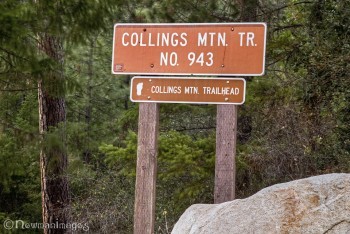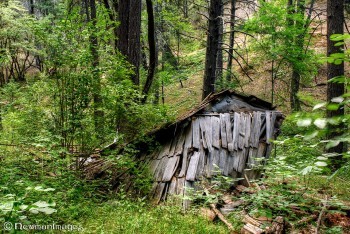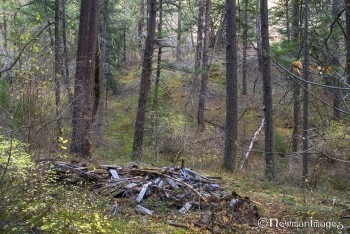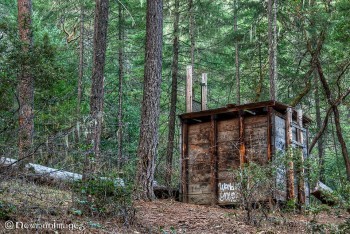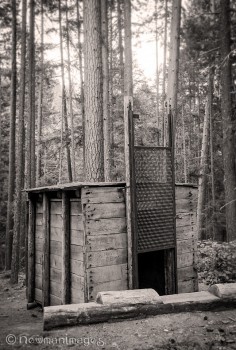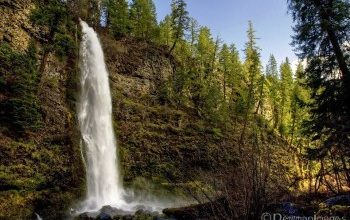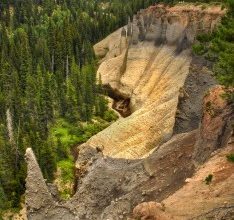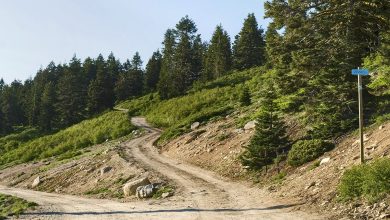The Bigfoot Trap
By NewmanImages
Today, the Bigfoot Trap can be reached via a short hike into the forest above Applegate Lake. But when the structure was built nearly 40 years ago, there was no road, dam or lake up there. Just wilderness. And the men who built the trap really expected to catch Sasquatch!
History. In 1969, as the Bigfoot craze was in full swing, an old miner named Perry Lovell was checking his claim near the Applegate River when he discovered a set of 18-inch footprints. They were six feet apart. Not long after, Lovell claimed to have seen several large creatures roaming through the dense forest across the canyon. His stories soon reached Roger Patterson, the man who’d filmed the iconic footage of a blurry Bigfoot walking and turning his head toward the camera (it happened near the lower Klamath). Patterson then shared the miner’s story with a wildlife filmmaker from Eugene named Ron Olson, who happened to be looking for a good place to build a Bigfoot trap. After traveling to the Applegate and interviewing the locals, Olson picked a spot not far from Lovell’s sightings. In 1974, he and his team hauled lumber and steel into the forest and built their trap on a wooded hillside above Grouse Creek.
It’s a Trap! The 10-by-10-foot structure, anchored by telephone poles, was designed to capture Bigfoot so he could be tranquilized, studied, filmed, tagged, and then released. It was supposed to work like this: Sasquatch ventures in, takes the bait (a goat or a rabbit carcass), and the big metal door drops like a guillotine. Then an alarm would buzz inside a miners’ cabin located down by the creek, and the miner would alert the researchers.
Big No-Show. Sadly, in the six years that the Bigfoot Trap was in use, it only caught (depending on which account you read) two bears, or a bear and a hunter, or a bear and a hippie. For safety reasons, the trap’s door was welded open permanently in 1980. In 2005, a ponderosa pine fell and nearly destroyed the structure. A year later, volunteers fixed the roof and replaced the rotting floorboards—which are starting to rot again. And there’s a lot of graffiti. But don’t let that take away from the experience of looking out at the forest from inside the world’s only known Bigfoot Trap.
Directions. Take 238 from Jacksonville to Ruch, then turn left onto Upper Applegate Road and drive 15 miles to Applegate Lake. Once you reach the dam, drive straight for another 9/10 mile; the Collings Mountain trailhead is a small pullout on the right about 300 feet beyond Hart-Tish Park. (Look for a white footprint painted on the trail sign.) Although trail goes all the way to nearby Collings Mountain, the Bigfoot Trap is only a short hike in. After leaving your car, the trail switch-backs down to a seasonal creek, which you’ll follow up the canyon for about 3/4 mile. When you see the remnants of the miners’ cabin on the right—which today is just a pile of rotting lumber—look for a wide spur trail on the left that goes up the hill. Follow it up for 200 feet, and you’ll find the trap. Watch out for poison oak along the trail—and of course, Bigfoot.
Find NewmanImages online at Facebook and Smugmug. Calendars available on Lulu.com. Check out our booth at the Ashland Artisan Emporium, and look for our images in the new book, Ashland, Oregon, by Barbara Tricarico.
